2025 International Medieval Congress
at Leeds:
Call for Papers
“Manuscripts as Worlds of Learning”
(2 Sessions + Roundtable)
32nd Annual IMC
Monday to Thursday 07–10 July 2025
(with In-Person and Virtual Components)
Deadline for your Proposals for Papers: 5 September 2024
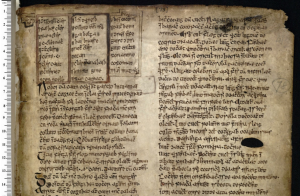
Dublin, Royal Irish Academy, MS 23 E 25, p. 73, top. Image via https://codecs.vanhamel.nl/Dublin,_Royal_Irish_Academy,_MS_23_E_25 via Creative Commons (CC BY-SA 3.0).
[Posted on 1 August 2024, with updates]
Building upon the successful completion of our RGME Inaugural Session at the International Medieval Congress (IMC) at the University of Leeds in July 2024, we announce the Call for Papers (CFP) for our activities at next year’s Congress.
For information about the Congress, see
Note that the general deadline for individual papers without specified sessions in a general pool is 31 August 2024.
The deadline for proposals for our RGME-sponsored Sessions is 5 September 2024. Please send your proposals directly to us as organisers; we will select the programmes by their deadline of 30 September 2024. (Instructions below.)
“Worlds of Learning” at Leeds in 2025
Next year’s Thematic Focus for the IMC is “Worlds of Learning”. The broad scope is described in the general Call for Papers: IMC 2025 – ‘Worlds of Learning’.
We invite you to submit proposals for a set of interlinked events planned for the Research Group on Manuscript Evidence (RGME) to focus on the power and potential of manuscripts to contain, convey, and embody worlds of learning within their span. In effect, given their structure and contents, as we approach them as beholder, user, reader, student, teacher, or admirer, they may carry worlds in our hands.
How might medieval manuscripts do so, variously for their medieval audience, later intermediaries, and our own times? How might and do they function as “Worlds of Learning” in their own right/write? We explore.
Update (14 August 2024): As interest grows, we plan several sessions for the 2025 IMC.
In another post, we present a Session with Papers devoted to “Game Knowledge and Knowledge of Games”, which follows up a strand in our RGME Inaugural Session this year.
Here we present a suite of events containing two Sessions with Papers accompanied by a Round Table with Discussion, all dedicated to “Manuscripts as Worlds of Learning”.
RGME @ IMC 2025:
“Manuscripts as Worlds of Learning”
For 2025, we explore the subjects of “Manuscripts as Worlds of Learning” in three steps, or panels, with a pair of Sessions of papers (Parts I–II) accompanied by a Roundtable discussion (Part III).
Session I considers “Manuscripts as Instruments of Learning and Teaching”
Session II examines “Manuscript Pedagogy and Pedagogy of Manuscripts”.
The Roundtable as Part III brings their insights to bear in a conversation about “Manuscripts in the Classroom, Then and Now”.
Aims
1. Session I: “Manuscripts as Instruments of Learning”
Whether substantial or slender, and even if now reduced to fragments, manuscripts small and large could in their own times, and still might in our own, open up worlds of exploration and learning. These virtues pertain to volumes as varied as massive authority texts, religious or secular (ranging from Bibles in full or Biblical Books to legal, scientific, medical, or alchemical texts); classbooks for diverse purposes and audiences; copies of poetry, recipes, or historical records; and scraps or segments of learning or lore gathered in commonplace books or miscellanies. Not only the original contents but also accretions, reworkings, and patterns of use, abuse, and transmission bring evidence to bear upon their abilities as witnesses across time and place to intentions for and practices of learning.
In many ways grounded upon their contents, including texts, glosses, commentaries, and navigational aids, medieval manuscripts can function as containers, conveyors, or embodiments of worlds to discover and teach. Their worlds speak volumes.
As Part I of three in our suite on “Manuscripts as Worlds of Learning”, this session welcomes papers on a wide variety of subjects, genres of manuscripts, approaches, and perspectives. We seek to explore how manuscripts of many kinds might effect learning, whether directly or indirectly, in the transmission of written materials between their makers, models or exemplars, readers, viewers, and users.
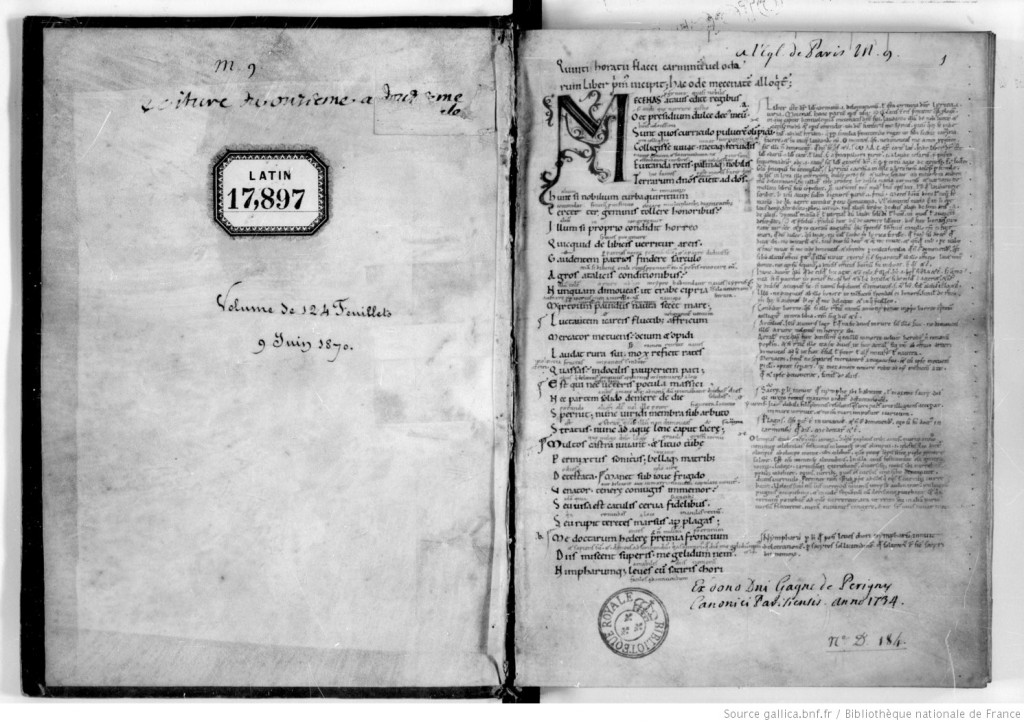
Paris, BnF, MS latin 17987, first opening with front endleaf and folio 1 recto. Ownership marks and first page of Horace’s ‘Carmina’, with commentary. Via gallica.bnf through Creative Commons.
2. Session II: “Manuscript Pedagogy and Pedagogy of Manuscripts”
As much as with later printed books used in scholastic settings, many manuscripts have been used for teaching purposes, and show evidence of this in various ways. The glossing of texts in multilingual contexts (which all medieval cultures were where vernaculars and Latin are in use, whether or not the vernacular is being employed for literary purposes), the utilization of chapter headings or titles within established texts for easier referencing, marginal manicules highlighting particular passages, and any number of other pieces of on-page aids in finding or understanding the written material present all demonstrate such pedagogical motives where manuscript composition is concerned. Classbooks, commonplace books, and miscellanies can be prepared with navigational aids for their study, while others acquire such aids as they are composed and subsequently used.
Further, manuscripts can be instruments of learning and teaching for modern people in medieval academic settings. The transferable skills of manuscript study include paleography, codicology, forensic examination, textual interpretation, and visual ornamentation, illustration, and organization, amongst other applications. Manuscript facsimiles, diplomatic editions, and online electronic reproductions can all be employed in classroom settings for these purposes. Innovative hybrid analogue and digital approaches to use of these manuscript materials in teaching continue to proliferate.
3) Round Table Discussion:
“Manuscripts in the Classroom, Then and Now”
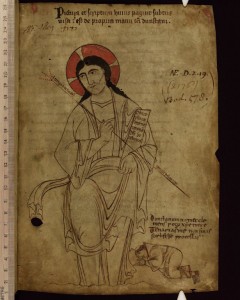
Oxford, Bodleian Library, MS. Auct. F. 4. 32, folio 1r. Saint Dunstan’s so-called Classbook, frontispiece, 10th century with additions. Photo: © Bodleian Library, University of Oxford (2015).
The Round Table seeks to synthesize insights from both these thematic directions as it presents perspectives from individual and collaborative experiences, initiatives, projects, and case-studies using manuscripts and/or surrogates as sources for study, teaching, and learning, whether in or beyond the classroom.
We welcome discourse from various perspectives and subjects about the challenges and advantages of teaching or learning from manuscripts
- as viewed directly in person,
- represented at a distance in photographic, pre-photographic, and other forms, or
- accessed in a combination of these traditional and updated formats.
For example, what measures might come into place where access, physically or digitally, is interrupted, so that improvisatory or innovative approaches are indicated? What works, and what works best? We seek advice.
Our Sessions of papers and Round Table are intended to focus on pedagogical initiatives, examples, and future prospects for the uses, issues, discoveries, and delights of manuscript studies in the classroom and beyond.
Inviting Your Proposals
The Research Group on Manuscript Evidence invites your proposals for our two sessions of papers and a roundtable treating the theme of “Manuscripts as Worlds of Learning”.
IMC 2025 Format: Choices for In-Person with Virtual Components
According to the IMC:
We are planning to host an in-person gathering in Leeds, with virtual involvement possible for those who are unable to attend in person. You will be asked when submitting your proposal about whether you would prefer to present your paper or session in-person or virtually and have the opportunity to confirm this if your proposal is accepted. It is important that you let us know your preference, as this information will inform our planning of both virtual and in-person elements.
— IMC Format
Deadlines for Proposals
- 5 September 2024 for your individual paper proposals for our RGME Sessions and Round-table Discussion
- 30 September 2024 for the RGME to complete and submit its programmes.
To prepare your proposals, see the IMC instructions
Ingredients for your Proposal
- Give the title for your paper
- Give your name as author/presenter, and up to one co-author/co-presenter. You should not submit more than one paper per IMC.
- Include a short abstract for the paper of no more than 100 words, in the language in which you want to present your paper
- Add 2-4 relevant index terms for your paper
Send your proposals for our Sessions to us at
When your proposals are accepted for our sessions, we will direct you to submit them through the
Spread the Word
Look for our RGME CFPs on the IMC 2025 website:
*****
Note on the Image
Dublin, Royal Irish Academy, MS 23 E 25, p. 73, detail. Lebor na hUidre (LU), or “The Book of the Dun Cow”, via RIA MS 23 E 25. Image via Creative Commons Attribution-ShareAlike 3.0 Unported (CC BY-SA 3.0). (Also online via isos.dias.ie.)
Dating from the 11th–12th centuries, the manuscript on vellum survives as a fragment of sixty-seven leaves, as a principal witness to medieval Irish texts.
In the manuscript’s copy of the first recension of Táin Bó Cúailnge (“The Cattle Raid of Cooley”), this page starts a table listing the Warrior-Feats of Cú Chulainn, and the incidents of the Death of Fer Baíth and the Combat with Lárine meic Nóis.
The text has section titles (standing with brackets to the left of initials) and gloss to right of the initial in column a with section title. and at end of that line.
*****
RGME @ Leeds and Kalamazoo in 2025
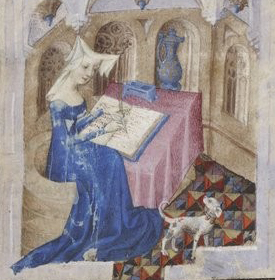
Paris, Bibliothèque nationale de France, Département des Manuscrits. Français 835, fol. 1r, detail. Frontispiece illustration of the scribal author for collection of texts by Christine de Pizan. Image via https://gallica.bnf.fr/ark:/12148/btv1b8449047c/f9.item.
Please note our plans for sessions at two international conferences in 2025: at Leeds for the IMC in July as well as at Kalamazoo for the ICMS in May. See our Call for Papers for the 2025 International Congress on Medieval Studies (Thursday through Saturday, 8–10 May 2025).
Proposals for our six sponsored and co-sponsored Sessions on a variety of topics are due by 15 September 2024 on that Congress’s ICMS Confex Portal.
For our activities at the 2024 ICMS, see our 2024 International Congress on Medieval Studies Report.
*****
Questions? Suggestions?
Visit our Social Media:
Join the Friends of the RGME. Send your favorite recipe for Lemonade (and perhaps its Story) for our Competition.
Register for our Events by the RGME Eventbrite Collection.
Attend our next Events if your timetable allows. Our next Events:
Consider making a Donation in Funds or in Kind for our nonprofit educational corporation powered principally by volunteers. Your donations and contributions are welcome, and can go a long way. They may be tax-deductible to the fullest extent provided by the law.
Remember to send us your Proposals for Papers for RGME Sessions + Roundtable at the 2025 IMC by 5 September 2024. See the instructions above.
Welcome!
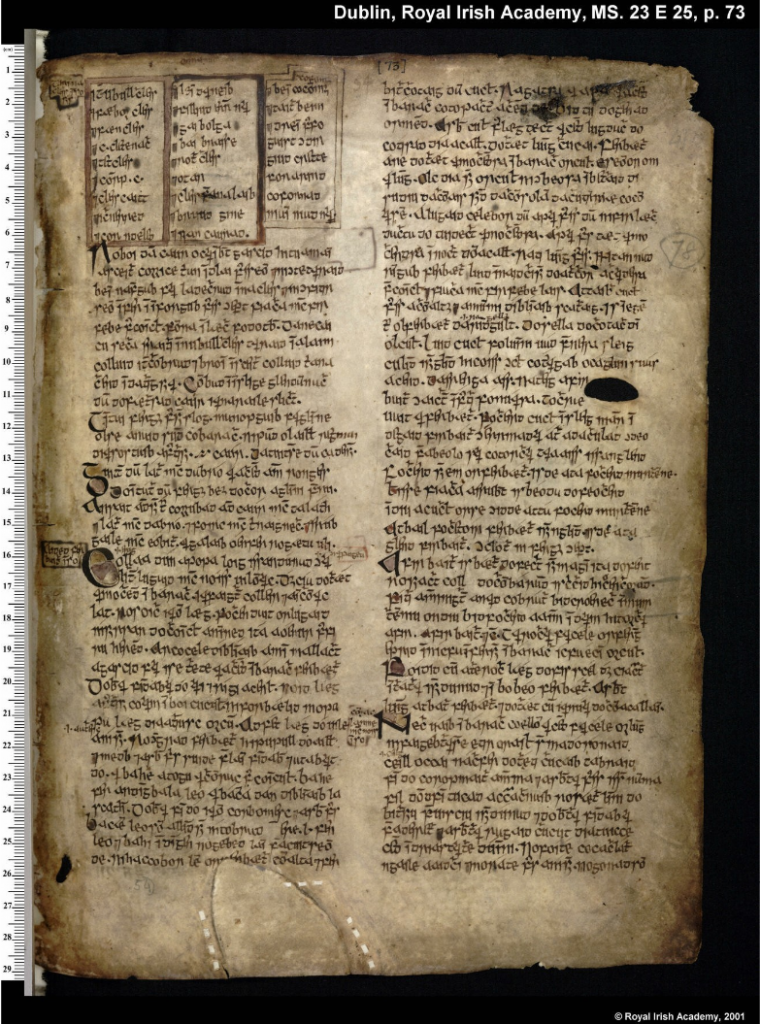
Dublin, Royal Irish Academy, MS 23 E 25, p. 73. Lebor na hUidre (LU), or “The Book of the Dun Cow”, via RIA MS 23 E 25. Image via https://codecs.vanhamel.nl/Dublin,_Royal_Irish_Academy,_MS_23_E_25 via Creative Commons (CC BY-SA 3.0).
*****

2025 International Medieval Congress at Leeds: Call for Papers
August 1, 2024 in Announcements, Call for Papers, International Medieval Congress, Leeds, Manuscript Studies
2025 International Medieval Congress
at Leeds:
Call for Papers
“Manuscripts as Worlds of Learning”
(2 Sessions + Roundtable)
32nd Annual IMC
Monday to Thursday 07–10 July 2025
(with In-Person and Virtual Components)
Deadline for your Proposals for Papers: 5 September 2024
Dublin, Royal Irish Academy, MS 23 E 25, p. 73, top. Image via https://codecs.vanhamel.nl/Dublin,_Royal_Irish_Academy,_MS_23_E_25 via Creative Commons (CC BY-SA 3.0).
[Posted on 1 August 2024, with updates]
Building upon the successful completion of our RGME Inaugural Session at the International Medieval Congress (IMC) at the University of Leeds in July 2024, we announce the Call for Papers (CFP) for our activities at next year’s Congress.
For information about the Congress, see
Note that the general deadline for individual papers without specified sessions in a general pool is 31 August 2024.
The deadline for proposals for our RGME-sponsored Sessions is 5 September 2024. Please send your proposals directly to us as organisers; we will select the programmes by their deadline of 30 September 2024. (Instructions below.)
“Worlds of Learning” at Leeds in 2025
Next year’s Thematic Focus for the IMC is “Worlds of Learning”. The broad scope is described in the general Call for Papers: IMC 2025 – ‘Worlds of Learning’.
We invite you to submit proposals for a set of interlinked events planned for the Research Group on Manuscript Evidence (RGME) to focus on the power and potential of manuscripts to contain, convey, and embody worlds of learning within their span. In effect, given their structure and contents, as we approach them as beholder, user, reader, student, teacher, or admirer, they may carry worlds in our hands.
How might medieval manuscripts do so, variously for their medieval audience, later intermediaries, and our own times? How might and do they function as “Worlds of Learning” in their own right/write? We explore.
Update (14 August 2024): As interest grows, we plan several sessions for the 2025 IMC.
In another post, we present a Session with Papers devoted to “Game Knowledge and Knowledge of Games”, which follows up a strand in our RGME Inaugural Session this year.
Here we present a suite of events containing two Sessions with Papers accompanied by a Round Table with Discussion, all dedicated to “Manuscripts as Worlds of Learning”.
RGME @ IMC 2025:
“Manuscripts as Worlds of Learning”
For 2025, we explore the subjects of “Manuscripts as Worlds of Learning” in three steps, or panels, with a pair of Sessions of papers (Parts I–II) accompanied by a Roundtable discussion (Part III).
Session I considers “Manuscripts as Instruments of Learning and Teaching”
Session II examines “Manuscript Pedagogy and Pedagogy of Manuscripts”.
The Roundtable as Part III brings their insights to bear in a conversation about “Manuscripts in the Classroom, Then and Now”.
Aims
1. Session I: “Manuscripts as Instruments of Learning”
Whether substantial or slender, and even if now reduced to fragments, manuscripts small and large could in their own times, and still might in our own, open up worlds of exploration and learning. These virtues pertain to volumes as varied as massive authority texts, religious or secular (ranging from Bibles in full or Biblical Books to legal, scientific, medical, or alchemical texts); classbooks for diverse purposes and audiences; copies of poetry, recipes, or historical records; and scraps or segments of learning or lore gathered in commonplace books or miscellanies. Not only the original contents but also accretions, reworkings, and patterns of use, abuse, and transmission bring evidence to bear upon their abilities as witnesses across time and place to intentions for and practices of learning.
In many ways grounded upon their contents, including texts, glosses, commentaries, and navigational aids, medieval manuscripts can function as containers, conveyors, or embodiments of worlds to discover and teach. Their worlds speak volumes.
As Part I of three in our suite on “Manuscripts as Worlds of Learning”, this session welcomes papers on a wide variety of subjects, genres of manuscripts, approaches, and perspectives. We seek to explore how manuscripts of many kinds might effect learning, whether directly or indirectly, in the transmission of written materials between their makers, models or exemplars, readers, viewers, and users.
Paris, BnF, MS latin 17987, first opening with front endleaf and folio 1 recto. Ownership marks and first page of Horace’s ‘Carmina’, with commentary. Via gallica.bnf through Creative Commons.
2. Session II: “Manuscript Pedagogy and Pedagogy of Manuscripts”
As much as with later printed books used in scholastic settings, many manuscripts have been used for teaching purposes, and show evidence of this in various ways. The glossing of texts in multilingual contexts (which all medieval cultures were where vernaculars and Latin are in use, whether or not the vernacular is being employed for literary purposes), the utilization of chapter headings or titles within established texts for easier referencing, marginal manicules highlighting particular passages, and any number of other pieces of on-page aids in finding or understanding the written material present all demonstrate such pedagogical motives where manuscript composition is concerned. Classbooks, commonplace books, and miscellanies can be prepared with navigational aids for their study, while others acquire such aids as they are composed and subsequently used.
Further, manuscripts can be instruments of learning and teaching for modern people in medieval academic settings. The transferable skills of manuscript study include paleography, codicology, forensic examination, textual interpretation, and visual ornamentation, illustration, and organization, amongst other applications. Manuscript facsimiles, diplomatic editions, and online electronic reproductions can all be employed in classroom settings for these purposes. Innovative hybrid analogue and digital approaches to use of these manuscript materials in teaching continue to proliferate.
3) Round Table Discussion:
“Manuscripts in the Classroom, Then and Now”
Oxford, Bodleian Library, MS. Auct. F. 4. 32, folio 1r. Saint Dunstan’s so-called Classbook, frontispiece, 10th century with additions. Photo: © Bodleian Library, University of Oxford (2015).
The Round Table seeks to synthesize insights from both these thematic directions as it presents perspectives from individual and collaborative experiences, initiatives, projects, and case-studies using manuscripts and/or surrogates as sources for study, teaching, and learning, whether in or beyond the classroom.
We welcome discourse from various perspectives and subjects about the challenges and advantages of teaching or learning from manuscripts
For example, what measures might come into place where access, physically or digitally, is interrupted, so that improvisatory or innovative approaches are indicated? What works, and what works best? We seek advice.
Our Sessions of papers and Round Table are intended to focus on pedagogical initiatives, examples, and future prospects for the uses, issues, discoveries, and delights of manuscript studies in the classroom and beyond.
Inviting Your Proposals
The Research Group on Manuscript Evidence invites your proposals for our two sessions of papers and a roundtable treating the theme of “Manuscripts as Worlds of Learning”.
IMC 2025 Format: Choices for In-Person with Virtual Components
According to the IMC:
We are planning to host an in-person gathering in Leeds, with virtual involvement possible for those who are unable to attend in person. You will be asked when submitting your proposal about whether you would prefer to present your paper or session in-person or virtually and have the opportunity to confirm this if your proposal is accepted. It is important that you let us know your preference, as this information will inform our planning of both virtual and in-person elements.
— IMC Format
Deadlines for Proposals
To prepare your proposals, see the IMC instructions
Ingredients for your Proposal
Send your proposals for our Sessions to us at
When your proposals are accepted for our sessions, we will direct you to submit them through the
Spread the Word
Look for our RGME CFPs on the IMC 2025 website:
*****
Dublin, Royal Irish Academy, MS 23 E 25, p. 73, top. Lebor na hUidre (LU), or “The Book of the Dun Cow”, via RIA MS 23 E 25. Image via https://codecs.vanhamel.nl/Dublin,_Royal_Irish_Academy,_MS_23_E_25 via Creative Commons (CC BY-SA 3.0).
Note on the Image
Dublin, Royal Irish Academy, MS 23 E 25, p. 73, detail. Lebor na hUidre (LU), or “The Book of the Dun Cow”, via RIA MS 23 E 25. Image via Creative Commons Attribution-ShareAlike 3.0 Unported (CC BY-SA 3.0). (Also online via isos.dias.ie.)
Dating from the 11th–12th centuries, the manuscript on vellum survives as a fragment of sixty-seven leaves, as a principal witness to medieval Irish texts.
In the manuscript’s copy of the first recension of Táin Bó Cúailnge (“The Cattle Raid of Cooley”), this page starts a table listing the Warrior-Feats of Cú Chulainn, and the incidents of the Death of Fer Baíth and the Combat with Lárine meic Nóis.
The text has section titles (standing with brackets to the left of initials) and gloss to right of the initial in column a with section title. and at end of that line.
*****
RGME @ Leeds and Kalamazoo in 2025
Paris, Bibliothèque nationale de France, Département des Manuscrits. Français 835, fol. 1r, detail. Frontispiece illustration of the scribal author for collection of texts by Christine de Pizan. Image via https://gallica.bnf.fr/ark:/12148/btv1b8449047c/f9.item.
Please note our plans for sessions at two international conferences in 2025: at Leeds for the IMC in July as well as at Kalamazoo for the ICMS in May. See our Call for Papers for the 2025 International Congress on Medieval Studies (Thursday through Saturday, 8–10 May 2025).
Proposals for our six sponsored and co-sponsored Sessions on a variety of topics are due by 15 September 2024 on that Congress’s ICMS Confex Portal.
For our activities at the 2024 ICMS, see our 2024 International Congress on Medieval Studies Report.
*****
Questions? Suggestions?
Send a note to director@manuscriptevidence.org or RGMEevents@gmail.com
Visit our Social Media:
Join the Friends of the RGME. Send your favorite recipe for Lemonade (and perhaps its Story) for our Competition.
Register for our Events by the RGME Eventbrite Collection.
Attend our next Events if your timetable allows. Our next Events:
Consider making a Donation in Funds or in Kind for our nonprofit educational corporation powered principally by volunteers. Your donations and contributions are welcome, and can go a long way. They may be tax-deductible to the fullest extent provided by the law.
Remember to send us your Proposals for Papers for RGME Sessions + Roundtable at the 2025 IMC by 5 September 2024. See the instructions above.
Welcome!
Dublin, Royal Irish Academy, MS 23 E 25, p. 73. Lebor na hUidre (LU), or “The Book of the Dun Cow”, via RIA MS 23 E 25. Image via https://codecs.vanhamel.nl/Dublin,_Royal_Irish_Academy,_MS_23_E_25 via Creative Commons (CC BY-SA 3.0).
*****
Tags: 'Commonplace Books', Authority Texts, Biblical Commentaries, Classbooks, History of Pedagogy, Instruments of Learning, International Congress on Medieval Studies, International Medieval Congress, Lebor na hUidre (LU), Legal Commentaries, Manuscript Miscellanies, Manuscript studies, Pedagogy, RIA MS 23 E 25, Worlds of Learning
No Comments »